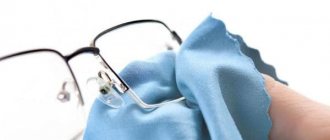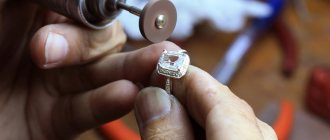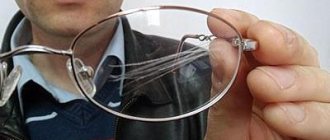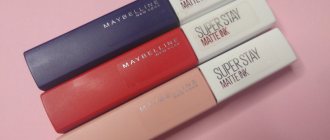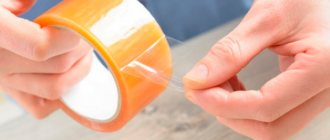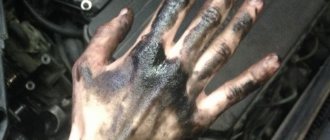Even with the most careful handling, glasses will develop scratches. They can be almost invisible or, on the contrary, quite large. Glasses not only lose their attractive appearance, but also cease to be beneficial for the eyes. Ophthalmologists do not recommend wearing glasses with defects: scratches impair vision and can lead to systematic headaches.
Share
Tweet
Share
Cool
Send
Causes of scratches
Scratches occur both during active use of the item and during storage (in a pocket or bag). Damage occurs due to dust particles settling on the glass. When a person wipes their lenses, these grains leave behind traces.
Less common causes of scratches include:
- friction on hard surfaces;
- poor care;
- accidental fall;
- weather factors;
- improper storage;
- frequent wiping with a napkin.
Glasses have a wide range of applications: sun protection, vision correction, creating a business image. Cheap models are often simply thrown away and replaced with similar ones. But for glasses specially made to order, this option is definitely not suitable.
You need to clean your lenses at least once a day. It's best to do this in the morning. Over the course of a day, a lot of dust and residue from protein reflections accumulate on glasses. If you limit yourself to the edge of the hem or sleeve, this will contribute to the appearance of new scratches (albeit not always noticeable).
Gradually, the optical capabilities of the glasses decrease. You have to strain your eyes, they become red. The signal of fatigue enters the brain, and from there it is transmitted throughout the body.
Wood varnish and Vaseline
Vaseline and wood varnish are a rather strange combination that hardly anyone would have guessed, but it works. Magically, wood varnish combined with Vaseline can repair scratched glasses lenses.
The bulbs will be juicy and large: how to choose the right onion set
There will also be electric bicycles: 67 more bike sharing stations will be installed in Moscow
Remove the bottom leaves of the tomatoes. Why do gardeners do this?
Simply spray a little polish on your lenses, then apply Vaseline and rub the mixture onto the glass to get rid of anything that's preventing you from seeing the world clearly. While these two remedies may not completely remove damage from your glasses, they will make the scratches much less noticeable.
Differences in polishing small, deep, extensive scratches
The glasses are carefully inspected to determine the extent of damage. It's easy to remove tiny abrasions yourself using a soft polishing cloth. Soap or toothpaste will be good helpers. With regular sanding, minor scratches will quickly disappear.
In case of deep damage, more serious actions are required: it is necessary to remove the surface layer of glass. Here you cannot do without special equipment. The polishing method depends on the material used to make the glasses. It is much easier to remove scratches from plastic lenses than from glass ones.
Can scuff marks be removed?
You can remove scratches from sunglasses if they are shallow . It's easy to check.
Simply run your fingernail over the defect. If he falls into damage, then the probability of success is low. During processing, the glass may simply burst.
Unlike deep defects, surface scratches can be easily repaired. For this purpose, various polishes with abrasive substances are used.
Before buying new glasses, you need to try to revive the old model . It is possible that the result will be positive and the item will last for some time.
How to clean glass lenses?
High-quality glass is quite resistant to external influences of a physical nature. They are durable. One of the disadvantages is the large weight: the diopters make the glass massive. It is difficult to remove scratches from glass glasses: not every composition can remove them from a hard surface.
If there is no special cleaning liquid and you need to remove dust from the glass, dishwashing gel and a soft cotton cloth will do. The material must be perfectly clean, otherwise damage will remain on the surface of the glass.
Soda
A liquid slurry is prepared from soda and water. The resulting composition is applied to a cotton pad and the lenses are treated with circular movements. The glasses are then rinsed with plenty of water. If necessary, the procedure must be repeated.
Paste GOI
GOI paste is a technical composition created for polishing optical glasses. It is also suitable for regular glasses. Before use, it is better to remove the lenses from the frame.
- The paste is applied to the felt cloth and the lens is placed on top.
- The glasses are rotated on the felt: this is how the lenses are polished.
- Remove any remaining mixture from the surface with a clean cloth.
- You don’t have to remove the lenses from the frame, but then you will have to act very carefully: the paste should not get on other elements of the glasses.
GOI paste is used not only for manual processing, but also for mechanical processing. The composition is rubbed in using a grinding machine at minimum speed. At high temperatures the glass will crack. A shaving machine is also suitable: the knives are replaced with a microfiber cloth.
Toothpaste
The substances included in the paste gently polish the outer layer of the lens, thereby eliminating unnecessary defects.
- A small amount of the product should be applied to the glass and rubbed over the entire surface with a soft cloth.
- It is important to do this as quickly as possible: the paste dries in a matter of seconds.
- The composition is washed off from the surface of the glasses after a few minutes.
- The final stage is to wipe the lenses dry. The main thing is that there are no traces left.
Dentifrice
The powder is mixed with water until a paste forms. The mixture is applied to the damaged surface and wait until it is completely dry. The dried crust is carefully removed. If you rush, you can ruin your glasses even more. The lenses are polished and rinsed.
Wood or glass polish
If the polish contains wax, it will easily cope with scratches on the lenses. First, wash the glasses thoroughly with dish soap and allow them to dry. The polish is applied to the glass and rubbed in with a soft cloth. The wax will fill the scratches and slow down the spread of cracks. The procedure can be repeated until the desired result is obtained.
CD polish
The composition is available in computer stores. It differs from household cleaning products in its careful treatment of cleaning surfaces. The main task of the disc compound is to eliminate minor damage. Lenses are processed according to the same principle.
Auto glass washer
Windshield washer solution is sold in any store (even large grocery chains). The composition was originally created not only for washing off liquids, but also for smoothing out small cracks on the surface. Moreover, this is a way to protect lenses from fog and dust. A small amount of washer is applied to the glasses and rubbed in a circular motion until all damage is completely removed.
Nail polish
Colorless varnish, like wax, fills all unevenness and forms a protective layer. You need to work with it with pinpoint precision: the composition dries quickly. To mask defects, use a wooden toothpick. It is dipped into the bottle and the tip is drawn along the surface of the lens. Only high-quality varnish is suitable for the job; it should not be thick or expired.
Car wax
Wax intended for polishing the car body is used for deep and large damage. Car polish is applied to the glass with a flannel rag. The wax must be rubbed in until the scratches disappear completely. At the final stage, the surface is wiped with a clean, lint-free cloth. Don't worry if you put more wax on your lens than required. Excess can be easily removed with a soft cloth.
Abrasive gel for glasses
This professional product is used to remove the top layer of lenses. If there is a shading cover, you will have to forget about it. The gel is suitable for caring for any type of goggles (including swimming goggles). When working, use protective latex gloves. The gel is applied to the damaged surface according to the instructions. Then the lenses are wiped with an alcohol wipe.
Alcohol
Alcohol does an excellent job of cleaning in combination with baking soda. This mixture instantly restores the condition of the lenses and eliminates damage. Residues from the surface can be easily washed off with running water. For minor damage, medical alcohol will be a lifesaver.
Water repellent spray
The lenses have a water-repellent layer: as a rule, it is the final layer. Therefore, a water-repellent spray can save your glasses from scratches. It is commonly used by motorists to protect their windshield. The spray is simply applied to the glasses and then wiped with a dry cloth. In addition, the composition can be used to prevent fogging.
Vaseline and wood varnish
Transparent wood varnish is best purchased in spray form. A large selection is available in construction stores. A small amount of varnish is applied to the lenses and then treated with Vaseline. The amount of Vaseline is as needed. Remove any residue with a dry, clean cloth, making sure there are no cracks left.
Crocus
This is a substance based on iron sulfate. It is easily recognized by its rich yellow or brown tint. Crocus is diluted with water mixed with baking soda. The composition will protect the lenses from unwanted damage. For polishing, use the sediment that falls after mixing the components. The resulting slurry is applied to the lenses and wiped with a soft cloth until the scratches completely disappear. After this, you need to rinse the glasses and wait until they dry completely.
Cerium oxide
It is a white or slightly creamy powder. To remove scratches, the oxide is mixed with water in a one to one ratio. The resulting thick paste is applied to the scratched lens and polished with hard felt.
Mustard powder and vinegar
This is a little-known but effective way to combat scratches. A paste of white vinegar and mustard removes any stains on glass and makes them shiny. The mixture is rubbed in a circular motion using a cotton pad.
After achieving the desired result, be sure to wash off the remaining paste. When rinsing glasses, do not spare water, otherwise the mustard may cause skin irritation.
Baking powder
Cooking powder for making pies and buns can also remove scratches on glasses. To work, prepare a thick paste from baking powder and water. Rub the composition into the lenses using circular movements. Glasses should be rinsed in plenty of water and dried on a soft cloth.
Monitor cleaning spray
The tool is intended for computer maintenance. The main task is to eliminate minor damage. It is applied to the scratched lens and then removed from the surface with a soft cloth. The process is repeated until the slightest trace remains of defects.
Paste for copper and silver
The composition is available for sale in jewelry stores and antique stores. One bottle will last a long time. The product is spread in a thin layer over the surface of the glass and then wiped with a velvet cloth. The liquid removes scratches well and masks cracks. If not all defects have disappeared the first time, the procedure can be repeated.
Glass etching agent
The drug is used when applying patterns to glass and mirror surfaces. You can buy the composition in a specialized store for needlewomen and artists. He can also handle the repair of plastic lenses. Even deep scratches become invisible.
Important rule: do not use glass lens cleaner. It is advisable to work with rubber gloves. The substance is applied to the glasses with a cotton swab or disk. It should not be kept on the surface for more than five minutes.
Vinegar and baking soda
Soda is dissolved in table vinegar. This composition can successfully remove minor scratches. This method is not suitable for serious damage. The components are mixed in equal proportions: a spoonful of soda and a spoonful of vinegar. The resulting slurry is applied to the surface of the lenses and left until a chemical reaction occurs.
Dishwashing liquid
Daily dishwashing detergent can remove small defects on plastic glasses lenses. The liquid is applied to the surface and wiped with a soft cloth. The disappearance of abrasions will be noticeable immediately. It is better to give preference to an environmentally friendly product made from natural ingredients.
Baking soda and water
Did you know that baking soda can also be used to clean glasses? Make a thick paste from baking soda and water. Then apply it with a soft cotton or woolen cloth and rub gently in a circular motion. Rinse the lenses thoroughly with water and dry them with a microfiber cloth. Again, the process may need to be repeated to get rid of deeper scratches. Thanks to this simple method, you won't have to insert new lenses into your glasses. However, when choosing this lens cleaning method, make sure you use good quality baking soda.
Features of grinding plastic lenses
Plastic lenses are becoming increasingly popular today. People prefer to buy such glasses because they are light and comfortable to wear. But if the operating rules are violated, they are easily damaged: cracks, scratches, and rainbow stains appear. Lenses should not be cleaned with caustic chemicals or solutions to remove greasy deposits.
Plastic can and should even be washed regularly with warm water and soap. At the optical store, you should purchase special compounds and wipes for cleaning lenses. They are not capable of damaging the surface and boast an antistatic effect. It is important that dust, grease and particles of aggressive compounds do not get on the glasses.
Monitor cleaning spray
Basically, this liquid is used by people who work in computer maintenance to restore the performance of computer drives. But it can also be used to get rid of scratches on your glasses.
The main purpose of monitor cleaning spray is to remove minor damage, making it ideal for your eyeglass lenses. Simply apply the liquid and wipe the surface with a cloth. But make sure the fabric is clean and soft to avoid adding unnecessary new scratches.
How to polish polarized glasses?
Sunglasses are the easiest to scratch: they are often worn on vacation, on the beaches, or taken with them on vacation. When a person is relaxed, the last thing you want to think about is safety measures. Carelessness during operation leads to poor visibility. Damage is repaired by polishing and filling irregularities. Suitable folk remedies: tooth powder, soda, furniture wax.
Toothpaste must be free of whitening additives and abrasive components, otherwise the lenses will suffer even more. It is also necessary to avoid contact with acids and ammonia compounds. Do not use alkali-based products. If the scratch is large, the lens will have to be changed, but it is better not to skimp on your health and buy new glasses.
Useful video
From this video you will learn how to polish glasses with a grinding machine and wait GOI:
Learn more about ways to polish glass at home in this video:
Important! Regardless of the product used, polishing glasses and removing scratches at home has one serious drawback: you can damage the dioptric parameters of the glasses, which for corrective optics is the final failure.
And even if the glasses look perfect in appearance after the work has been done, using them may cause eye fatigue and no effect on improving vision.
In this regard, polishing deep scratches requires turning to professionals, but in most cases the appearance of such serious defects leads to the need to purchase new optics .
Disadvantages of DIY Cleaning
If no method gives the desired result, it is better to leave amateur efforts to save glasses and entrust this matter to professionals. They will polish the lenses using special equipment. Polishing at home has a number of disadvantages. Traditional methods only deal with “hair” scratches. In more severe situations, there is a risk of depressions forming at the cleaning site, causing optical distortions.
Expert opinion
Danilova Elena Fedorovna
Ophthalmologist of the highest qualification category, Doctor of Medical Sciences. Has extensive experience in diagnosing and treating eye diseases in adults and children.
Attempts to remove scratches on your own are often ineffective. The surface of the lenses is too sensitive: it becomes damaged and becomes cloudy. Chemical particles easily scratch not only glass, but also plastic. And a soda solution can lead to persistent plaque and a decrease in transparency.
Doctors believe that removing scratches on lenses yourself only guarantees a cosmetic effect. Despite their excellent appearance, their optical properties may be damaged.
After self-cleaning, the special coating, which is antistatic and water-repellent, is sometimes washed off. During polishing, at least a microscopic part of the material is removed, which violates the geometry of the refractive surface. This may lead to picture distortion.
Non-abrasive toothpaste
It is actually quite a famous remedy when it comes to removing scratches from glasses. It is very effective and will keep your glasses looking like new.
Apply some toothpaste to the lenses and rub it in from side to side. Rinse off the paste with warm water and then dry the glass with a clean cloth. If the scratches are too deep, you may have to repeat this process three to five times until the scratches are completely gone.
It will take you no more than three minutes to return your glasses to perfect condition.
Dentifrice
If you are more used to using toothpaste, then most likely you do not keep toothpowder at home. But when you learn about its benefits for glasses (and teeth), you may change your mind.
The guy “challenged the carpet to a duel”: a harsh way to do housework (video)
Visitors to Russian cinemas will be prohibited from bringing in their own food and drinks.
For any occasion and for every taste: stylish styling ideas for medium-length hair
All you need to do is simply dilute a little powder in a little water and stir it to a paste consistency. Apply the mixture to the damaged lenses and wait about 20 minutes.
Using a microfiber cloth, carefully remove any remaining paste and enjoy the result.
Clear nail polish
If you are a woman, then applying nail polish will be an easy task for you, but if you are a man, then you will finally understand the complexity of this process.
This method of removing scratches requires care and precision. Here's what you need to do: Gently dip the edge of a wooden toothpick into the polish and then apply it to the lenses. Your hand must be steady so as not to stain the frame.
You also need to keep in mind that you don't need a thick varnish, otherwise it will dry before you evenly distribute it over the surface. Do not touch the lenses until the polish is completely dry.
Prevention measures
Proper care and careful handling will help you avoid problems with sunglasses . Strictly follow the manufacturer's recommendations, the basic rules and glasses will serve you for a long time:
store only in a special hard case of the appropriate size;- subject to regular cleaning with soap suds or special wipes, sprays;
- additionally purchase and apply protective films;
- do not use acetone-containing compounds or abrasive substances;
- do not place lenses face down on hard surfaces;
- Do not expose to too high or low temperatures, do not leave in the open sun or car panels;
- remove the frame, holding the temple with both hands;
- use glasses only for their intended purpose (do not, for example, wear them as a hairband);
- Avoid contact with the product with varnishes, air fresheners, and other chemicals.
Beautiful women's glasses frames (photo)
Is it possible to paint shoes a different color?
Last chance - sandpaper
Sandpaper, even at the thought of it, seems like a very dangerous item to use on your precious glasses, and this is an absolutely valid concern. The method is more likely to damage the glasses than to fix them, so you should resort to it only as a last resort, when there is nothing left to lose. If your glasses are still quite usable, do not use sandpaper under any circumstances. Leave this option for glasses that have a lot of scratches and the glass is almost unusable.
The method is based on grinding the lens with sandpaper to the depth of the scratch. The procedure reduces the thickness of the lenses and may impair vision correction and UV protection functions. Sandpaper is best used for cosmetic glasses or sunglasses. It is not suitable for glasses prescribed by an optometrist.
Sand the lenses for a minute or two. Once you feel you have eliminated the scratches, stop. You can then use a buffing wheel to further polish and smooth the lenses. This will give them a new shine.
After the procedures, wipe your glasses with a microfiber cloth and remove all excess glass particles. Be careful because tiny glass particles can cause significant damage to your eyes if they get into them. In some cases, you may even need medical attention if too many particles get into your eye.

